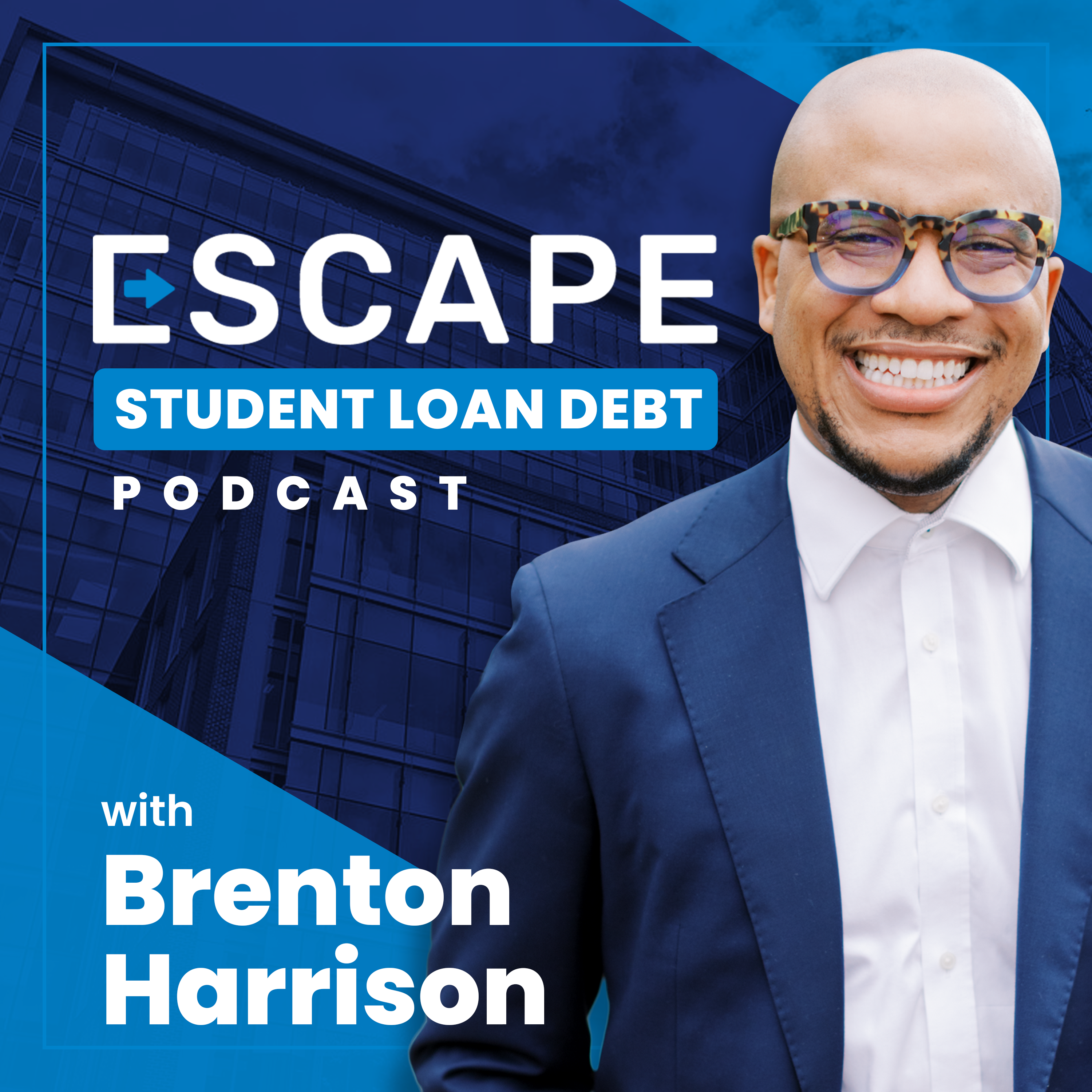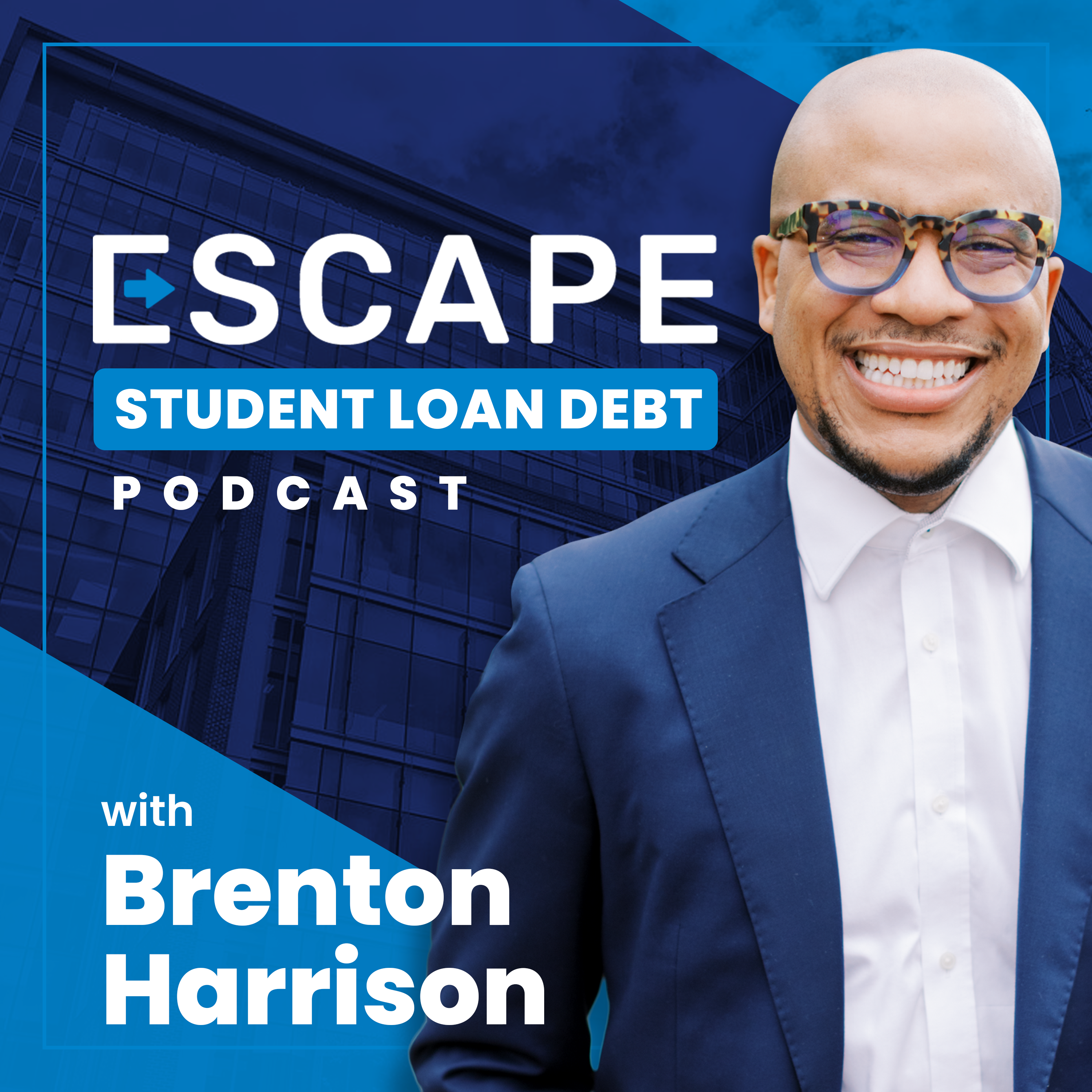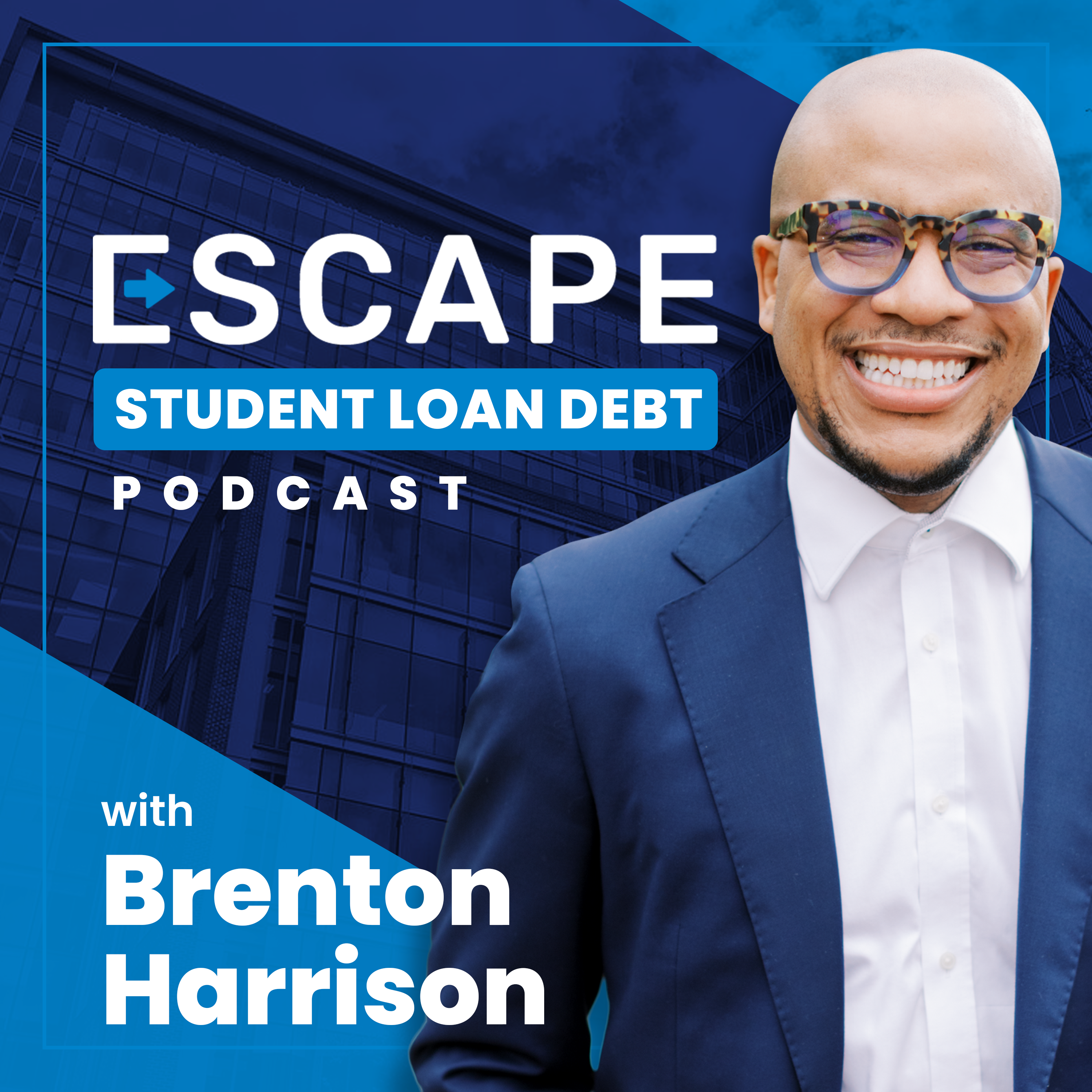Episode Transcript
[00:00:00] Speaker A: In this episode, we're going to walk you through the paper version of the direct Consolidation Loan application and show you how to complete it. Now, this could be helpful for all borrowers, but specifically helpful for those who are trying to complete the double consolidation loophole for parent PluS loans. Let's get started.
[00:00:16] Speaker B: Are your student loan payments or loan balances a major obstacle in your financial life? Then tune in and let's escape student loan debt.
[00:00:27] Speaker A: Hello. My name is Brenton Harrison of Escape student Loan debt and your host for the Escape Student Loan Debt podcast. Over the past couple episodes, we've been talking about parent plus loans. We did an episode on how dangerous they can be and how punishing the payment plans can be. Because under the Income driven repayment plan umbrella, there's only one payment that you can use, that payment plan being the Income contingent repayment Plan. We showed you an example of a household with an adjusted gross income of $100,000, a family of four. And under the SAve plan, their household payment would be less than $300 a month under that plan, whereas that same family of $400,000 adjusted gross income under the Income Contingent Repayment Plan, which is the only one eligible for parent plus loans, their payment would be almost $1,200 a month. So really, really punishing options, or lack of options when you have parent plus loans and you're trying to pay them back with those IDR plans. In the last episode, we talked about the double consolidation loophole, where you can take those parent plus loans, and through two different phases of consolidations, you could strip the parent plus status off of those loans and make it eligible for more forgiving income driven repayment plans. So we went through those details in the last episode. If you're following along with us on a whiteboard, you can see it on screen. If you're not, I'll describe it to you. What you would do in that scenario is you would have to have the ability to put your loans, those parent plus loans, or whatever loans you have into at least two different groups. So in the example you see on screen, there are four parent plus loans, and we've grouped loans one and two into their own group and loans three and four into that second group. And the first thing that you complete is a paper consolidation application to put those two groups into new consolidation parent plus loans. And we covered that. This process has to be done with paper applications, because if you try to do it online, the system will see two applications and they'll simply cancel one of those applications out. Now I'll be transparent. When we started doing these videos, I thought that we would try to get away from parent plus loans as quickly as possible because I just assumed that there weren't that many people in our audience who had them. I was mistaken. We have had probably more questions than we've had on any video that we've ever done about how to complete this process for the paper consolidation application. So today we're going to walk you through step by step, how to do phase one of this, which is taking those two separate groups and using a paper application to put them into new consolidation loans. So let's pull up the direct consolidation application, and we're also going to pull up the instructions and we'll pull all of this in the show notes so that you'll have it. If you're looking along on screen, you're looking at a consolidation application. If you're listening, I'm going to describe it to you and we're going to go through these sections to just describe some things that might trip you up. The first section is literally just borrower information, last name, first name, Social Security number, date of birth, your permanent address. The second section is references. You have to have at least two references. You have to have known these people for at least three years and they can't live with you. So it's going to ask for their last name, first name, their permanent address, their email and their phone number. Now, is it likely that they're going to contact these people? No, but you probably at least want to send somebody a text to let them know that they've been listed as a reference on your student loan. But that is section two, the reference information.
So now we go to page two. When you're going to see a section that says loans that I want to consolidate. Now, this is just for that first grouping. Remember that we have to do two separate applications. So when you see this section, recall that you're not putting all of your student loans, you're just putting the ones that you want to consolidate on this particular application, and you have to have a good bit of information in order to complete it. The first thing it asks for is a loan code. So if you're following along with us on screen, you're looking at instructions for how to complete a direct consolidation loan application. Again, we'll put this in the show notes if you are listening and not watching, and you can see that different student loans have different codes that are associated with them. For example, direct subsidized loans. Their loan code is D direct unsubsidized loans. Their loan code is L. So if you have parent plus loans, a direct plus loan, if you go further down the list, the code for that is U. So for all of your direct plus loans that are included in this first group, you're going to put U as your loan code. It also asks for your loan servicer. So remember we talked about in these first applications, you're going to send these two groups of loans away from the servicer that you want to end up with. So, for example, if you want to end up with Mohila, you don't need to send the first grouping of loans to Mohila. You need to do two separate loan servicers. But in this section, it's not asking where you want to send it to, it's asking who is your current loan servicer. So you're going to put your current loan servicer their address and their phone number. If you're wondering how to find that, you can ask your servicer. You can log on to their contact Us section. But we also have put a document together as of eleven seven 2023 of all of the listed loan servicers with their address and their phone numbers. ED Financial Mohila Advantage Nellnet, ECSI Default Resolution Group. So if you're needing just a quick reference sheet for who your current loan servicer is and what their mailing address may be, you can reference that sheet that's in the show notes. And lastly, you'll need your loan account number and your estimated payoff amount. So if you owe $100,000, but you owe it across five different loans, you can't just put $100,000. You have to go onto your loan statement or go onto your loan servicer site, find each loan account number and the estimated payoff amount for that particular loan doesn't have to be exact, just has to give them some idea to identify the loan that they're looking for when your new servicer goes in to pay off and consolidate these various loans. So you need to do that for all of the loans that you want to consolidate in Group One. Not all the loans, just the ones in Group One. And in the next section, you'll see that there's a section that's titled loans that I do not want to consolidate. This is where you would put the loans that you've put in Group two. So for all intents and purposes, for this application, it's going to look like they're staying put. We know that they're not. They're going to be consolidated elsewhere. But as far as this first application goes, you want to list all of the loans that you have in Group Two, and you have to have the same information, the loan code, the servicer address, the account number, and the current balance of those loans. There's also a question here that we just scrolled over, and I want to make sure that I don't overlook it. There's a question 17 that says grace period, end date. So it's asking you to put the month that you expect your grace period to end. Let me explain what that means. When most of us graduate, if you have student loans, the federal government gives you a six month grace period before you have to pay them back. But when you consolidate a loan, it cancels that grace period unless you ask them to delay the consolidation. So if you have an expected grace period end date, they're essentially saying, hey, are we consolidating loans that might have a grace period? If so, let us know when that grace period is due to end so that we don't do anything that cancels out that grace period unnecessarily. So that's why they're asking about it in Question 17. This is how you put the two different groups of loans together, loans I want to consolidate and loans that I don't. And after the break, we'll tell you the next steps to get these applications completed and mailed off to their respective servicers.
[00:07:52] Speaker B: This is the Escape Student Loan Debt.
[00:07:54] Speaker C: Podcast, a show for established professionals whose student loan payments or loan balances are impacting their marriage, their business, their credit, or their dream of achieving home ownership.
[00:08:06] Speaker B: We'll be right back.
Are you interested in learning the tools and techniques we use to get student loans forgiven, reduced, reorganized, or expedited? Well, great news. We're currently updating our flagship course, escape student loan debt, to reflect the current changes in the student loan landscape. To stay up to date on the launch of the course and opportunities to sit in on our live recording sessions, head to escapestudentloandet.com and join our email list.
[00:08:35] Speaker A: Now.
[00:08:38] Speaker C: You'Re listening to the Escape Student Loan Debt podcast.
[00:08:42] Speaker B: Subscribe now@escapestudentloandet.com.
[00:08:45] Speaker C: Welcome back.
[00:08:47] Speaker A: All right, we're back from the break, and we have filled out the majority of the information that is needed on this application, and we're now on page five on screen where you just see the borrower's signature, where you're going to sign this form and put the day's date that you signed it. And then after you have signed it, there's a series of instructions and legalese in terms of what you are admitting to on this application and that you're being truthful. And then at the end you're going to see a section that says Insert servicer address. Now this is just a boilerplate template application, so there's not going to be a servicer address here. And now we have to get to the part of this where we actually go forward and mail this to a servicer. If you're following along with us on screen, there's a section on the instructions that says where to send your completed direct consolidation application. And it says mail pages one through five and your completed note and any other required forms to the following address. Now, what are those other required forms? Most of the time when they're referencing another required form, they're talking about a payment plan request form. So they're saying you've consolidated this loan. We also want you to tell us which payment plan you want to choose for these new loans. Now, I will tell you if you want to be safe, we'll put the application to a payment plan, like an income driven payment plan request in the show notes so that you have it. But I will also say, I've seen plenty of times people send in these direct consolidation loan applications without a payment plan request and it still gets processed, but that's what they're referencing when it comes to the forms. And when you have those forms, you would mail all of them off to the various loan servicers. Remember, you don't need to mail it to the servicer that you want to be the end result. You can pick any two random services. You don't need to overthink it because they're not going to keep these loans for the long haul anyways. We just need two different places where we can hold these different loans. Send it anywhere other than default resolution group. Default Resolution Group is a loan servicer for people whose student loans are in default. So short of sending it there, you should be good to go anywhere you want to go. Now to set expectations, it's going to take six to eight weeks for both of these applications, not necessarily one after the other. They're hopefully going on at the same time. But this is not a fast process. And when you complete this stage of the process, remember that you're going to have new loans. They may communicate with you about the steps and the status of these applications, but you're going to have consolidation loans that are consolidated plus loans. That second step can be done online, which we've shown in previous episodes, which we'll link to in the show notes as well on how to consolidate online. And it's an important distinction because that last consolidation can be done online. And when you do it online, it will have a newly consolidated loan that strips its parent plus status. And at that point, after the loan is consolidated, you'll be able to pick any payment plan that you choose. And I put an emphasis on after because I see people get frustrated all the time, and sometimes they direct that frustration at me where they'll have done the paper applications, they'll be trying to consolidate that loan for the last time online. And when they're doing it online, it asks for them to pick a payment plan, and they still see that the income contingent repayment plan is the only one that's available. The reason it's the only one that shows is available online, even for that last consolidation, is because it's looking at the loans as they currently are, and it's seeing that they're still plus loans. So of course, it's only going to give you that ICR option. You have to complete the process, and once you have that new loan without the plus on it, then you can apply for an income driven repayment plan. And at that point, you should be able to choose whatever you would like. Now, when you're mailing off this application for the first two paper apps, I would highly advise you to do certified mail. It's not something I would just put a couple of stamps on and think, oh, okay, I hope they got it. Loan services are notorious for missing mail overlooking mail. So I would make sure that you have a paper trail of when it was sent and when it was delivered so that you can track receipt. But aside from that, these are the steps that you need to take if you're trying to do the double consolidation loophole. As a reminder, this needs to be completed before July of 2025, after which point this loophole that we're discussing will have closed. And if you have that parent plus loan, you'll be stuck paying ICR, which is a very, very cost prohibitive plan, or trying to pay off the loans in full, which in many cases is not feasible either. Hope this was helpful. Let us know in the comments if you have any more questions that we can answer, and I will see you guys in two weeks.
[00:13:19] Speaker B: So, from escape student loan debt, this was the Escape Student Loan Debt podcast, a show for established professionals whose student loan payments or loan balances are impacting their marriage, their business, their credit, or their dream of achieving homeownership.


